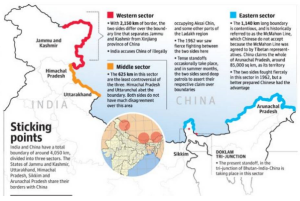Context:
Japan’s Foreign Minister meets India’s External Affairs Minister S Jaishankar in New Delhi.
More on News:
Key Discussion held between India and Japan:
News Source: The Indian Express
Context:
Recently, the Prime Minister of India addressed the inaugural session of Semicon India 2023, which is being attended by industry executives from across the world.
About Semicon India 2023:
About the India Semiconductor Mission (ISM):
|
News Source: The Indian Express
Context:
The Union Ministry of Electronics and IT (MeitY) and Papua New Guinea signed a memorandum of understanding (MoU) for sharing India Stack.
About India Stack:
The following APIs are considered to be a core part of the India Stack.
| Additional Information:
About Application Programming Interface (API):
|
News Source: PIB
Context:
The Union government is planning to set up the 16th Finance Commission during the fiscal year 2023-24.
More on News:
About Finance Commission(FC):
Their recommendations cover three main aspects:
Recommendations are advisory, the Union government typically accepts them with minor modifications. |
News Source: The Hindu
Context:
The Commission for Air Quality Management (CAQM) in the National Capital Region (NCR) has announced a revision in the existing Graded Response Action Plan (GRAP).
About Graded Response Action Plan (GRAP):
Key features of GRAP:
Revised GRAP to come into force from 1st October 2023, it includes:
News Source: PIB
Context:
The recent horrifying sexual violence against Kuki-Zomi women by majority Meiteis, in Manipur’s ethnic clashes between the two communities, has yet again woken the country up to the vulnerability of women’s bodies during a conflict.
History of Violence Against Women in Armed Conflict in India
Past Instances of violence towards women:
|
Impact of Conflict on Women
International Efforts to Prevent Exploitation of Women in Armed Conflict
Way Forward
| Quote:
“It has probably become more dangerous to be a woman than a soldier in an armed conflict.” – PATRICK CAMMAERT, FORMER UN PEACEKEEPING COMMANDER |
News SOurce: The Hindu
Context:
Highlights of Meeting:
| Areas of Discussion | Description |
| China Commitment |
|
| Concerns raised by India |
|
| Other Key Issues Discussed |
|
Role of BRICS Platform:
Background Of India-China Relationship
 However, there have been several instances of conflict and tensions over the last few decades, including the 1962 Sino-Indian War and border clashes that occurred as recently as 2021 and continue to this day.
However, there have been several instances of conflict and tensions over the last few decades, including the 1962 Sino-Indian War and border clashes that occurred as recently as 2021 and continue to this day.Way Forward:
News Source :The Hindu
SC Verdict on Newsclick Shows Adherence to Due Pro...
Stay Invested: On Chabahar and India-Iran Relation...
Credit Rating Agencies, Impact on India’s De...
Catapulting Indian Biopharma Industry
Globalisation Under Threat, US Import Tariffs Have...
Global Report on Hypertension, Global Insights and...
<div class="new-fform">
</div>
